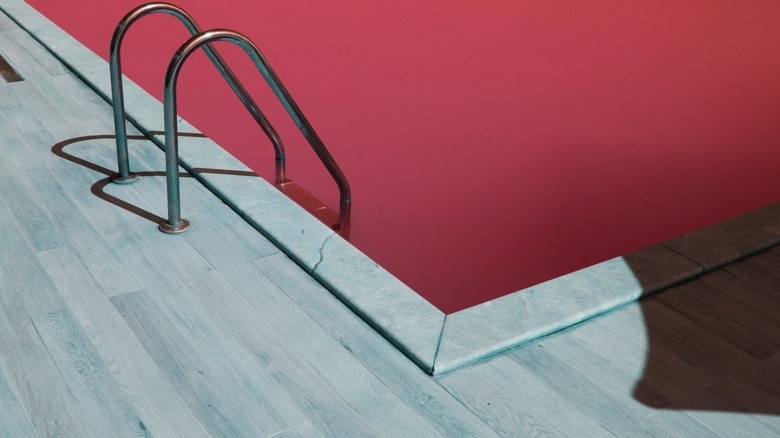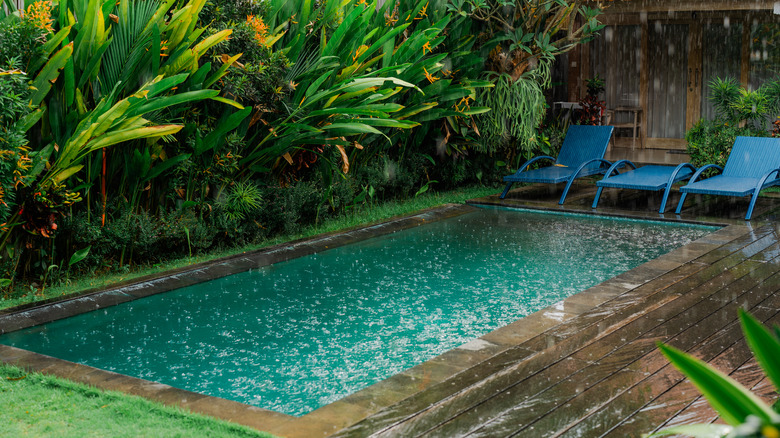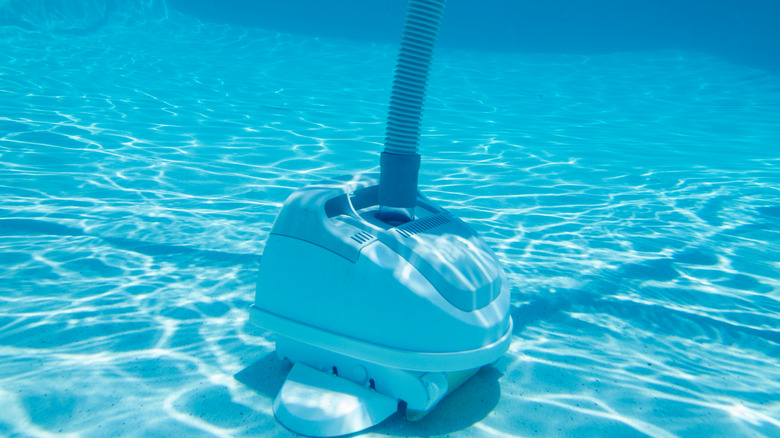What It Means If The Water In Your Swimming Pool Starts Turning Red
You eagerly wait for the perfect time to open the pool in your backyard and dip in the cool, blue waters to beat the summer heat. However, your refreshing plans might grind to a screeching halt if you notice specks of red in your pool water. The presence of red algae (though it's bacteria) or pink slime in your pool can be alarming at best, and irritating or nauseating at worst. Although the clustered bacteria tend to cling onto solid surfaces like pool ladders, sides, toys, and inflatables for dear life, they might turn the pool water red if things get out of hand, since they multiply at an alarming rate.
The good news is the red color is often indicative of an imbalance in your pool's alkalinity, pH, and water hardness. So, restoring the balance between the three and following a few other steps in tandem, like filtering, brushing, and vacuuming, should do the trick. But you must avoid swimming in the pool until the issue is resolved, since the toxins might induce vomiting, dizziness, respiratory issues, or harm your lungs (and skin!). Don't forget to wear protective eye goggles and gloves to keep the contact to a minimum while cleaning the pool. Full-length clothes are recommended, too. Plus, disinfect them as soon as you're out of the pool, or you risk trailing the clinging bacteria back inside with you.
What causes a red pool?
Bacteria tend to be the primary culprit behind a red pool, with the easiest vector being human beings. Generally, the bacteria from our skin leap into the water every time we enjoy a swim, which can lead to red algae formation. If you're on top of pool maintenance, you don't need to worry much about this source since the chemicals will take care of the bacteria introduced by us.
However, that's not the only way bacteria find their way in. Environmental activities like rain and wind play an important role, too, since bacteria (in huge quantities) can easily enter the pool water through these mediums and lurk inside without your knowledge. Dirty pool toys or garden hoses are another source. Simply put, it's incredibly simple for red algae to establish itself in your beloved swimming pool and turn the water and other surfaces red. Given the quantities of bacteria that can enter, reside, and proliferate in a pool from these various sources, it's often difficult for chemicals to kill them all.
That being said, red algae isn't the only reason your pool water takes on a red hue. Traces of iron and manganese might also turn the water red. This is possible if pipes supplying water to the pool have developed an unsightly layer of rust. Metallic water from wells, pumps, or heaters are other sources worth looking into. The chlorine in the pool water will cause the metals to rust and take on a red (or slightly brown) tinge.
How to clear up red pool water?
Red algae can block the pool filters and reduce water circulation. It'll also make it easier for you to skid on slimy surfaces. So, clearing red pool water is essential. Start by removing the inflatables, ladder (if it's detachable), and toys from the pool, then disinfect them using vinegar. You should also run the filter for a day and backwash it one to two times to clean your pool filter. If your old cartridge has clocked over 3,000 hours, switch it with a new one.
Arm yourself with a dedicated brush (opt for a wire one to clean a plaster pool) and rub the red algae clinging to the walls twice a day. Next, use a pool vacuum to clean dead algae out of your pool. Follow this with a chemical treatment that focused on the holy trio: alkalinity, hardness, and pH.
Get muriatic (or dry) acid — chlorine works best at lower levels — to bring the pH in the 7.0 to 7.2 range. Keep the cyanuric acid between 30 and 50 ppm to eradicate the lingering bacteria. The alkalinity should be between 80 and 120 ppm, whereas the water hardness should be between 150 and 250 ppm. Give the pool a shock using calcium hypochlorite and keep the chlorine at 20 ppm, then test the shock level after 10 to 12 hours to ensure it's still around 20 ppm. Keep the filter on, backwash it, and keep brushing and vacuuming until the chemical balance and pH level (7.2 to 7.8) are restored.


